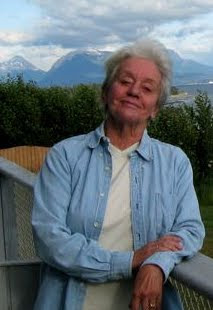Continuing our series on small and regional publishers, we bring you this interview with Carla Helffrich, editor at McRoy and Blackburn.
Tell us about McRoy and Blackburn. Who started it? Why? Which books were among the first you published? What niche do you hold in the marketplace?
It’s all my fault…I was the (first real) editor for the University of Alaska Press, and for very good reasons, its editorial board then limited potential publications to “scholarly nonfiction relevant to Alaska, the Arctic, and the North Pacific rim.” This led to some painful decisions when good fiction—my area of greatest interest—came sailing over the transom, often with sad notes saying in effect, “I know you don’t usually publish fiction, but could you think of making an exception? They just don’t get it in New York.” A real low point came when I read a draft of Velma Wallis’s first book and had to send her to Epicenter (in fact, my husband made a point of introducing me at gatherings for some time thereafter with, “Meet the editor who rejected Two Old Women”). But the last straw came when a good friend (and published author) showed me the much-rejected manuscript he had of a children’s book, Bucket, elegantly written and brilliantly illustrated by his mother, a retired Bush teacher, with collages make from colored carbon paper. Stunning on all fronts, but not acceptable to New York publishers. That should be published, said I, and so I will. Thus was born McRoy (after my husband, oceanographer Peter McRoy) & Blackburn (after Henry Blackburn, a literature-loving scientist who introduced me to both the ‘Titus Groan’ novels and the poetry of Seamus Heaney) with the publication of Bucket in 1993. Our position in the marketplace is more of a slippery slope than a niche: only Alaska fiction.
What are some of your best-selling titles? Has there been a shift in what readers expect and which Alaskan authors/books do well?
Neil Davis’s collection of tales focused on gold mining over the decades in the Interior, Caught in the Sluice, keeps on moving well for us; he has a solid knowledge of mining and its history as well as a cheerfully raunchy sense of humor—and virtually no competition in the subject. Don Porter’s Alex Price adventures, especially Yukon Murders, have also sold well; Don’s a terrific salesman for his own work. Nita Nettleton’s ‘Wild’ series, which I’ve described as light-hearted chick lit in bunny boots, has begun to catch on also. I think in general Alaska fiction is growing up, so to speak. Although a lot of pure entertainments with an Alaska setting are still the most numerous—and I happily publish them—we’ve seen some Serious Literature emerging in fiction, notably Seth Kantner’s Ordinary Wolves (but I can point with pride to M&B’s own prize-winning The Red Mitten too). I think if you look over the work of some of our most productive fiction authors—Stabenow, Henry, Straley for examples—you’ll find a general tendency toward writing that’s both sharper and deeper as they’ve honed their craft and as readers have learned they can expect work of a high standard.
How many books do you typically publish each year? In which genres? Over the years, what kinds of changes have you made to your list?
We turn out only one or two books a year, and sometimes one of those is a reprint of an earlier title with an uncomfortably low stock; we’ve vowed to keep all our titles in print. The chief change in the list has been a move away from fiction for children—we’ve not done well at selling the titles we have. A Christmas-themed one is on track for next year, though, so we never give up completely.
Describe your ideal author. In other words, if one of us wanted to wow you with a proposed project, how would we do it?
You’d show off both your craft and your ability to read! I’m forever astounded by manuscript submissions from people who don’t think sound grammar and accurate spelling should concern fiction writers, or from those who haven’t bothered to read what’s on the web site in the Guide to Authors.
The economy has hit publishing hard. Are you seeing any encouraging signs? What is the future for small and regional publishers?
Not yet, and pretty grim. Changes in technology make it easy for any doofus to ‘publish’ a book, avoiding all that annoying business of dealing with persnickety editors, so there’s more regionally flavored bad writing for sale. But somebody had to make the last buggy whips, and somebody gets to be the last Alaska fiction publisher standing…
What do you most want to communicate to readers about your books and to writers about submissions?
I hold with the old adage that writers of fiction lie their way to the truth; I want to publish the truth about Alaska, its people, its rot and its glory, in well-written fiction. For me, a good book creates a world that a reader truly experiences, not just reads about. It breaks us out of the prison of our own skulls. Send me a manuscript that does that, and I’ll publish it, guaranteed!


——-
After going through this article I have decided to bookmark this site found this really interesting & thanks a lot for keeping the blog Lively with such interesting blogs.
___________________
Andrew
Online Marketing of your brand